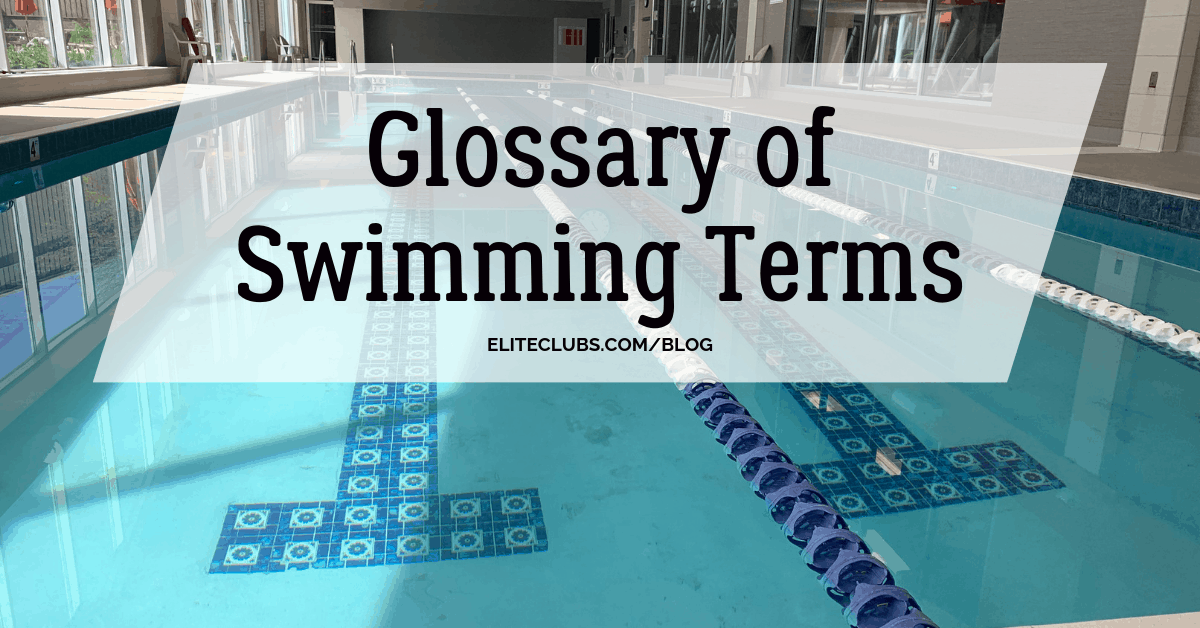
If you’re not a regular swimmer, you might not be familiar with common swimming terms associated with exercise or racing. While there are plenty of terms in the swimming world, we’ve compiled a list you might hear us using around the clubs during swim lessons or classes.
Glossary of Swimming Terms
Read through our swimming glossary to learn about different elements of swim strokes, equipment, etc!
Backstroke – A swimming stroke executed on the back and usually consists of alternating circular arm pulls and a flutter kick. Backstroke is also known as the back crawl.
Bilateral Breathing – Breathing on both sides of your body while you are swimming creates smooth, even strokes. You get a better balance in the water by alternating your breathing and you develop uniform muscles. Breathing to both sides of your body becomes even more important when you move from the pool to the open water.
Breaststroke – Breaststroke is a swimming style in which the swimmer is on their chest and the torso does not rotate. It is the most popular recreational style due to the swimmer’s head being out of the water a large portion of the time, and that it can be swum comfortably at slow speeds. Breaststrokers’ arms and legs work together at the same time, in the pull-breathe–kick-glide sequence. Timing is crucial for breaststroke swimming.
Butterfly – A swimming stroke in which the arms are thrown forward together out of the water while the feet kick up and down. The arms move simultaneously in an hourglass shape and the legs do the dolphin kick.
Circle Swim – When sharing a lap lane with another person, the practice of swimming in a rotational pattern – like a long oval – is known as circle swimming. That means you go down the length of the pool to the right of the black line, and swim back on the left of it.
Dolphin Kick – A swimming kick used mainly in butterfly in which the legs are extended straight back and moved up and down in unison with a slight bend in the knees on the upward movement.
Flutter Kick – a brisk, alternating, up-and-down movement of the legs when swimming with certain strokes, such as the crawl. The kick should originate from the hips, with the rest of the leg relaxed and following the hip motion.
Flip Turn – A technique used by swimmers to change direction when the end of the lane is reached. Flip turns are used for front and back crawl.
Freestyle – Freestyle means that in an event so designated the swimmer may swim any style, except that in individual medley or medley relay events, freestyle means any style other than backstroke, breaststroke, or butterfly. Most swimmers choose to swim front crawl for freestyle events.
Front Crawl – a style of swimming in which the swimmer faces downwards and moves their arms alternately in strokes, breathing to the side and using the flutter kick
Glide – Gliding while swimming happens before a stroke begins, between strokes, after a flip turn or at the end of a lap. Proper gliding technique allows a swimmer to maintain momentum while preparing for the next stroke. Body positioning varies depending on the circumstance.
Kickboard – A buoyant rectangular board held by a swimmer while developing kicking techniques.
Lap Swimming – Lap swim is designed for more organized swimming up and down the length of the pool repeatedly. This is how the pool is set up for competitive swim practice and meets, or for people who are exercising on their own.
Saltwater Pool – A pool that uses a salt chlorine generator as part of its sanitization process. Electrolysis is used on salt molecules to create chlorine, which is then put in the pool as sanitizer. Saltwater pools are generally less harsh on suits, skin, and hair than traditional chlorine pools, and are more ecologically-friendly.
Swim Cap – A tightly fitted, skin-tight garment, commonly made from silicone, latex or lycra, worn on the head by recreational and competitive swimmers to decrease resistance in the water.
Water Aerobics – (waterobics, aquatic fitness, aquafitness, aquafit) is the performance of aerobic exercise in fairly shallow water such as in a swimming pool. Done mostly vertically and without swimming typically in waist deep or deeper water, it is a type of resistance training that puts little to no stress on the joints.
A great way to learn more about the terms in this swimming glossary, or better yet, practice the techniques would be to take swimming lessons! Click on the button to inquire about swimming lessons at Elite Sports Clubs!
Inquire About Swim Lessons!If you’d like to learn more about fitness or tennis terms, you can check out our respective glossaries!